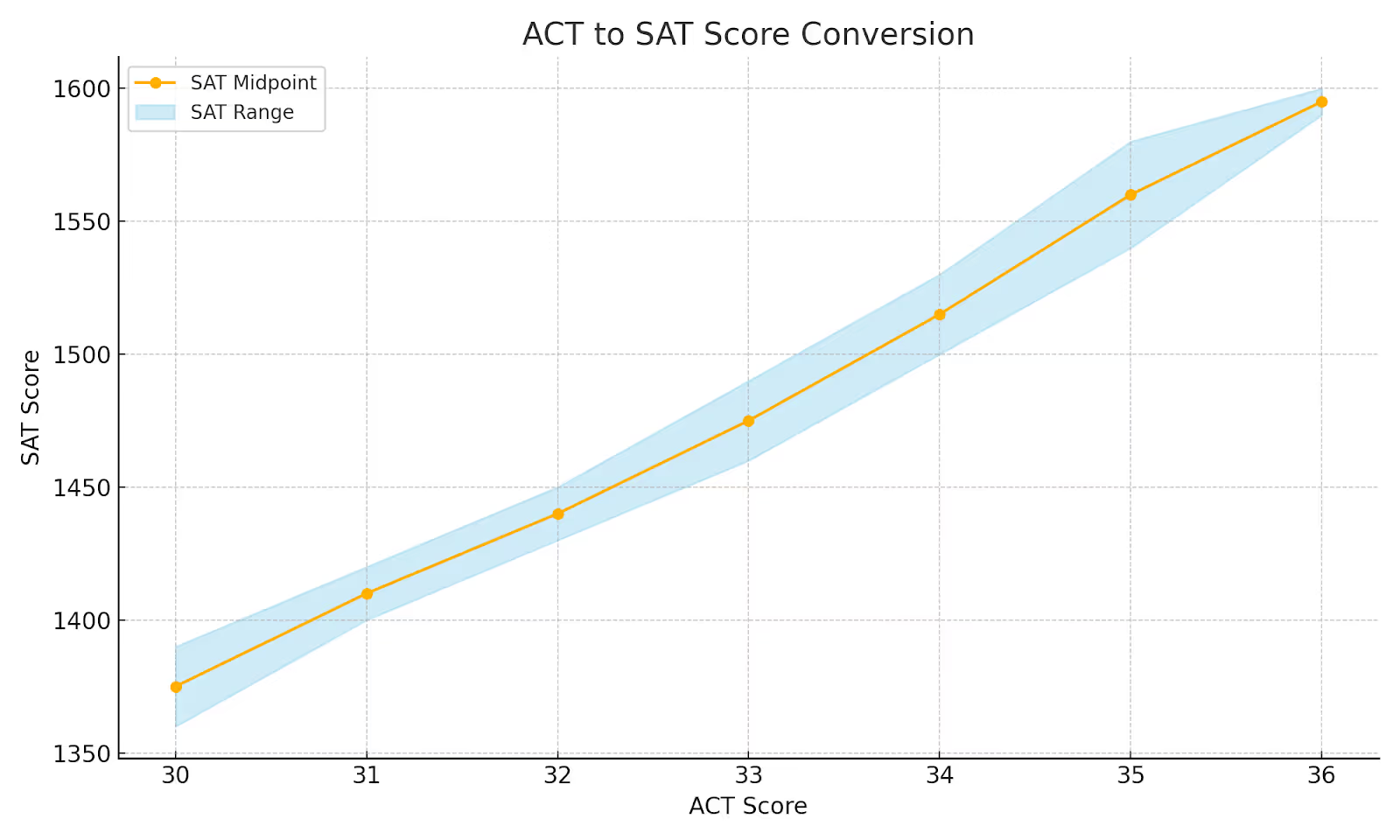




Key Takeaways
- Understand how ACT and SAT scores compare using official concordance tables.
- Choose the test that best fits your strengths and testing style.
- Use score conversions to guide prep plans and college application strategy.
Are you wondering how ACT and SAT scores compare, or whether the recent changes to both tests affect which one you should take? You're not alone!
Many high school students, parents, and tutors are navigating the evolving standardized testing landscape. The SAT went fully digital in March 2024, introducing adaptive testing and a shorter format, while the ACT is rolling out major changes starting April 2025, including making the science section optional and reducing test time. With these updates, understanding how your skills align with each test's format has become more important than ever.
Whether you're a student trying to determine which test plays to your strengths, a parent helping your teen decide how to prepare, or a tutor looking for the best way to guide students, knowing how ACT and SAT scores convert can help you make informed testing decisions.
We'll break down the official ACT to SAT conversion tables and explain how these score comparisons can guide your test prep strategy.
Why Compare ACT and SAT Scores
Understanding how your ACT and SAT scores compare isn't just about numbers—it's about making strategic decisions for your college admissions journey. While colleges accept both tests equally, each has distinct formats, timing, and content approaches that may favor different student strengths.
The challenge of different scoring systems
Since the SAT is scored out of 1600 and the ACT uses a 36-point scale, direct comparison requires official concordance tables. These tables, created jointly by the College Board and ACT, don't equate scores but provide a tool for finding comparable scores.
A concorded score is not a perfect prediction of how a student would perform on the other test, but it offers valuable guidance for test selection and college planning.
Official ACT to SAT conversion table
Based on the most recent official concordance tables released in 2018, here are key score comparisons:
Strategic uses for score conversion
Understanding these conversions helps you:
- Identify your stronger test: Take practice tests for both exams and compare converted scores to see which showcases your abilities better.
- Make informed prep decisions: Focus your study time on the test where you're more likely to achieve a competitive score.
- Choose which scores to send: If you've taken both tests, submit the higher equivalent score to colleges.
- Set realistic target scores: Use conversions to establish goal scores that align with your college preferences.
Important considerations
The official concordance tables for the paper SAT and ACT can still be used for the digital SAT and ACT, meaning recent test format changes don't affect these comparisons.
However, while a concordance table can tell you what your SAT score maps to on the ACT, it does not indicate whether your SAT scores are significantly stronger than your ACT scores. The best way to determine which test suits you is to take full-length practice tests of both.
If you’re leaning toward the ACT, understanding your scores is just the beginning—next, it’s all about applying ACT tips and strategies to improve and maximize your performance.
ACT to SAT Conversion Table (Official Concordance)
With recent changes to both the SAT and ACT, understanding how your scores translate between these tests has become more crucial for strategic test planning.
The ACT to SAT conversion process uses official concordance tables released in 2018 to help students, parents, and tutors navigate these different scoring systems. These concordance tables can still be used for both the digital SAT and the enhanced ACT, providing reliable guidance as both tests continue to evolve.
Example Conversion in Action
Let's say you scored a 30 on the ACT. According to the official concordance tables, this translates to an SAT score range of 1360–1380. This information is especially valuable if you're applying to schools that accept both tests or want to determine which score better reflects your academic strengths.
Here’s a simple visual chart to help you quickly see how ACT scores align with SAT equivalents:

This visual can be especially helpful for students using ACT prep apps or digital study tools, as it allows for quick reference and goal-setting.
Making the Most of Your Conversion
- Strategize your prep: Use your ACT to SAT conversion to decide which test to focus on, especially if you’re stronger in one format or prefer the digital ACT format.
- Set realistic goals: Knowing your equivalent SAT score helps you set clear, achievable targets for improvement.
- Leverage technology: Many ACT prep apps now include built-in conversion tools, making it easier to track your progress and compare your potential across both exams.
Important considerations
Remember that concordance tables don't equate scores but provide tools for finding comparable scores. A concorded score isn't a perfect prediction of how you'd perform on the other test. The most accurate way to compare your performance is taking full-length practice tests of both exams under realistic conditions.
Understanding ACT to SAT conversion empowers you to make strategic decisions about test selection, prep focus, and score reporting—ultimately helping you present your strongest academic profile to colleges.
How to use the ACT-SAT comparison
Navigating the world of college admissions means making smart, informed choices, and the ACT-SAT comparison is one of your most powerful tools.
With the changing digital SAT scoring algorithm and evolving SAT trends, understanding how your scores stack up can help you chart the best path forward, whether you’re a student, tutor, or parent.
1. Find your best-fit test
Not all tests play to the same strengths. By comparing your ACT and SAT scores using the latest concordance tables and understanding SAT and ACT score equivalents, you can pinpoint which exam truly highlights your abilities.
For example, some students find the digital SAT’s adaptive algorithm more intuitive, whereas others prefer the straightforward pacing of the ACT. Try practice tests for both, analyze your performance, and let the data, including your SAT and ACT score equivalents, guide your decision.
2. Tailor your prep strategy
For tutors, the ACT-SAT comparison is a goldmine. It allows you to customize prep plans based on each student’s unique score profile.
If a student’s SAT score is consistently higher, focus on digital SAT strategies and the latest SAT trends, like mastering adaptive modules or time management. If the ACT results are stronger, shift gears to ACT-specific prep. This targeted approach saves time and boosts confidence.
3. Strengthen your admissions game plan
Colleges often accept both ACT and SAT scores, but some may “superscore” or consider only your highest results. By understanding which score is stronger, you can make strategic decisions about which results to submit.
Keep an eye on SAT trends, such as the increasing importance of digital testing and changing score distributions, to ensure your application stands out.
4. Leverage technology and data
Modern test prep isn’t just about books and flashcards. Use digital tools and apps that incorporate the latest SAT scoring algorithms and ACT-SAT comparison features. These resources can help you track progress, identify weak spots, and adapt to new testing formats, like the digital SAT.
Should you switch from SAT to ACT (or vice versa)?
Deciding whether to switch from the SAT to the ACT—or the other way around—isn’t just about chasing a higher score. It’s about understanding your unique strengths, how you handle different test formats, and where you’re most likely to shine.
With the digital SAT now in play, many students are re-evaluating their options and wondering if a switch could give them an edge.
Key considerations before you switch
Before making your decision, ask yourself these questions:
Where do your strengths lie?
- Are you math-heavy, thriving on problem-solving and data analysis? Or are you more verbal-heavy, excelling in reading comprehension and grammar?
- The SAT tends to emphasize evidence-based reading and math, while the ACT includes a science section and often moves at a faster pace.
How do you handle test format and pacing?
- The digital SAT uses an adaptive format, which can feel different from the ACT’s straightforward structure.
- The ACT is known for its tight timing, so if you struggle with SAT anxiety, you may want to consider which format feels less stressful during practice.
What’s your prep timeline?
Switching tests means adjusting your study plan. If you’re close to your test date, focus on last minute digital SAT tips or take a free digital SAT practice test to gauge your readiness before making a decision.
Are you comfortable with digital testing?
The digital SAT’s algorithm adapts to your performance, which some students find motivating, while others prefer the predictability of the ACT’s paper or digital format.
When switching from ACT to SAT (or vice versa) makes sense
You might consider switching if:
- Your practice scores on one test are consistently higher than the other.
- You’ve hit a plateau with your current test and want a fresh start.
- The format or pacing of the other test better matches your strengths and test-taking style.
- You have enough time before application deadlines to prepare effectively for a new test.
When to stay the course
Sticking with your current test may be the best choice if:
- You’re already well-prepared and have taken several practice tests.
- Your timeline is tight, and switching would add unnecessary stress.
- You’re seeing steady improvement and feel confident with the material.
Pro tips for switching from ACT to SAT (or vice versa)
- Take a free digital SAT practice test or a full-length ACT practice test to compare your comfort level and scores.
- Use last-minute digital SAT tips to boost your confidence if you’re taking the SAT.
- Address SAT anxiety by practicing under real test conditions and using mindfulness techniques.
There’s no one-size-fits-all answer. Weigh your strengths, comfort with digital formats, and timeline before deciding. The best test is the one that lets you perform at your highest level—so choose the path that feels right for you and stick to a focused prep plan!
How can tutors use score conversion in prep planning?
Tutors today have powerful tools at their disposal to personalize prep plans, and ACT to SAT score conversion is at the heart of strategic guidance. By analyzing students’ converted scores, tutors can quickly identify which test format aligns best with a student’s strengths and learning style. This data-driven approach allows tutors to allocate study time more effectively, focusing on the exam most likely to yield higher results.
With virtual class software and interactive video learning platforms, tutors can seamlessly integrate score analysis into remote sessions, sharing concordance tables, practice results, and targeted resources in real time.
These digital tools also enable tutors to:
- Track student progress continuously and adjust prep strategies as needed.
- Provide tailored lessons that focus on specific skill gaps revealed by score comparisons.
- Engage students with interactive content and real-time feedback during virtual classes.
- Share customized practice materials aligned with the student’s preferred test format.
Ultimately, using score conversion in prep planning empowers tutors to deliver more customized, results-oriented support, whether students are prepping for the SAT, ACT, or considering a switch between the two.
Final thoughts
Choosing between the SAT and ACT—or even switching between them—doesn’t have to feel overwhelming. In this guide, we’ve explored the ins and outs of ACT to SAT conversion, compared updated concordance tables, and looked at how your strengths, test format preferences, and timelines all play a role in making the best decision for your college journey.
We’ve also seen how tutors and students alike can leverage digital resources, from virtual class software to video learning platforms, to personalize prep and boost confidence.
But here’s the real game-changer: using smart tools like EdisonOS. With its advanced tracking and analytics for both SAT and ACT, EdisonOS takes the guesswork out of score comparison and prep planning. You get clear insights, easy-to-read charts, and actionable feedback—all in one place—so you can focus on what matters most: reaching your highest potential.
Frequently asked questions

Tutors Edge by EdisonOS
in our newsletter, curated to help tutors stay ahead!
Tutors Edge by EdisonOS
Get Exclusive test insights and updates in our newsletter, curated to help tutors stay ahead!
Recommended Reads
Recommended Podcasts






.png)




.png)
.webp)
